Philippa Moore's Blog, page 11
April 1, 2020
zucchini slice
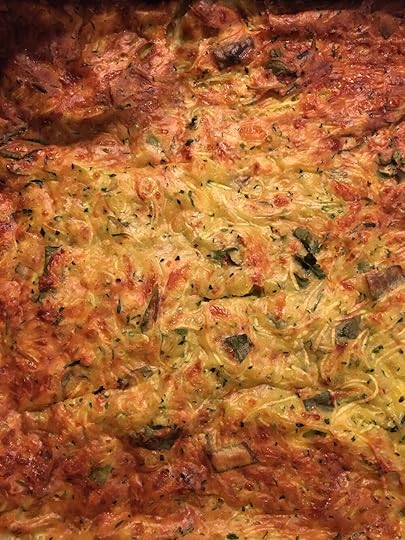
The humble zucchini slice - one of Australia’s favourite dishes. No doubt we “borrowed” it from another nation! Zucchini slice appeared regularly on my family dinner table when I was a child and I was always dismayed when it did because I thought it was “boring”. But with the glut of zucchini in my vegetable garden at the moment, I thought I’d “Phil-ify” this family favourite and lo and behold, it’s delicious! And with the addition of fresh and dried herbs, including an Australian Bush Herbs mix I picked up from one of my favourite shops on the mainland, it’s anything but boring.
This dish is the perfect vehicle to use up a glut of zucchini, and any other vegetables you might have lying around that need using. You can also throw in any cheese you want to use up. It’s the ideal dish for these strange times when we’re all trying to make the most of what we’ve got.
If you’ve got a food processor, I highly recommend fitting the grater attachment and grating the onion, zucchini and cheese all together. An absolute breeze and takes about 20 seconds from start to finish. Just watch your fingers!
Zucchini sliceServes 6
6 large, preferably organic, eggs
1 1/2 - 2 cups grated cheese of your choice (I used parmesan and cheddar)
3 large zucchini (about 1kg), grated
1 large onion, grated
1 1/2 cups self-raising flour
2 teaspoons Australian Bush Herbs mix (optional)
1 teaspoon dried basil
4 spring onions, finely chopped
Large handful of fresh mint, parsley and thyme (or another preferred combo of fresh herbs), finely chopped
Salt and pepper, to taste
Preheat the oven to 200 C. Grease a large baking pan or lamington pan (I use a baking pan I’d normally make lasagna in).
Whisk the eggs in a large mixing bowl with a bit of salt and pepper, then add all the rest of the ingredients. I tend to do this in stages - add the grated zucchini and onion, mix it in a bit, then the cheese and flour, then the seasonings, fresh herbs, etc. You want it all mixed nicely together with no lumps of flour.
Once thoroughly combined, scrape the mixture into your greased tin and spread out evenly. You can top with more cheese if you like but I tend not to.
Bake in the hot oven for around 35 minutes or until risen and golden on top. Put a knife or a skewer in, as if you’re testing a cake, and if it comes out clean, you’re good to go!
Allow the slice to sit for about 10-15 minutes before cutting into generous pieces. You can serve it as is, or with any accompaniment you like - salad, green beans, broccoli - but as the slice contains green veg already, my favourite way to serve this is with homemade potato wedges and a big dollop of homemade chutney.
March 29, 2020
mexican barley soup
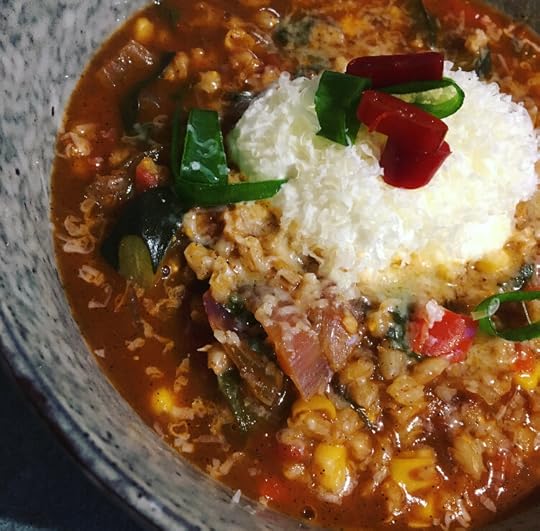
This is a fabulous soup for using up that bag of pearl barley you’ve possibly had lurking in your pantry for a few years. Or, it might have been the only grain you could find at the supermarket recently!
Cheap, filling and nutritious, I personally LOVE barley and particularly love it in this spicy, warming soup.
I like to use Pasilla chilli powder in this soup because it’s fruity and mild so as not to cause offence to the less-enthusiastic chilli lovers in the house. By all means make it as hot as you like and use your favourite chilli powder. A Mexican one will naturally give it a more authentic flavour. Chipotle and Ancho are widely available and both very good.
And please note, when I say “finely chopped”, I mean however finely you like/can be bothered! I don’t mind chunky onions and pieces of garlic in my soup.
Mexican barley soupMakes at least 6 servings
2 red onions, finely chopped
4 garlic cloves, finely chopped
4 stalks silverbeet (or chard, or spring greens, or kale, whatever greens you like/have), finely chopped, leaves and stalks
2 teaspoons Pasilla chilli powder or your preferred chilli powder (see note above)
2 teaspoons ground oregano
1 teaspoon smoked sweet paprika
1/2 teaspoon hot chilli flakes
250g pearl barley
1 x 800g tin peeled tomatoes
1 litre of stock - vegetable or “beef style” (I use the widely available Massel powder)
Worcestershire sauce (or vegan equivalent) to taste
1 red capsicum (pepper), finely chopped
1 cup frozen or canned corn kernels
1 zucchini (courgette), finely chopped
Spring onions, green part only, chopped
Pickled jalapeños, to serve
Greek yoghurt or sour cream and grated cheese, to serve
Drizzle some olive oil in a large, heavy-based stockpot and place over medium-high heat. Add the onion, garlic and silverbeet stalks (reserve the softer green leaves for later) and cook, stirring occasionally, until starting to soften. Add the spices and pearl barley, stirring to coat. Add the tomatoes and stock, then bring to the boil.
Once boiling, add some Worcestershire sauce (to your taste, I like it for the umami factor), the red capsicum, corn and zucchini. Stir to combine, add a little more stock if you think it needs it (I usually take this opportunity to clear out the dregs of jars of appropriately flavoured sauces/pastes/chutneys I have lurking in the fridge with water, such as tomato paste, tomato chutney, chilli sauce, etc. It all adds great flavour) and return to the boil.
Reduce the heat to a simmer and cover. Cook for approximately 20 minutes or until the barley is cooked (it will still have a little bite but it will be soft). Add the chopped silverbeet leaves (or whatever greens you’re using) and the chopped green spring onions. Simmer for another 5 minutes.
Taste, season with salt and pepper, and then ladle into soup bowls, topping with a swirl of yoghurt/sour cream, grated cheese and pickled chillies.
March 27, 2020
my favourite podcasts for inspiration, motivation + courage

Photo by PhotoMIX Ltd. from Pexels
When I lived in London, I listened to podcasts daily. I had an hour to kill at the start and end of each day commuting to and from work, and I’d normally take a long walk at lunchtime too. So, over the years, I listened to a lot of them!
As a freelancer, podcasts are still one of my favourite ways to get out of my own head and gain some wisdom and advice.
Sometimes, when I’ve spent a long day at the desk and feel I’ve been going nowhere, I’ll take a break, stretch my legs and get some fresh air - and I’ll usually pop on one of these podcasts to give me some inspiration, comfort, renewed energy or a different perspective.
Magic Lessons with Elizabeth GilbertThis podcast is a few years old now (recorded in 2015 and 2016) but I’m so grateful it’s still online because every single episode of it is gold and balm for the creative soul. If you loved the book Big Magic, you must listen to this wonderful podcast.
The premise behind it is that, around the time her book Big Magic was released, Liz Gilbert - who surely needs no introduction, certainly not to readers of this website! - put out the call to artists all over the world to write her a 200-word essay about what they were struggling with creatively, whether it was fear, writer’s block, disappointment, or anything in between. Liz then picked half a dozen or so people to appear on the podcast who she encourages on their creative path, to move beyond their fears and find their joy in creativity again. She gets a few guest stars in to help as well, who are all very knowledgeable, motivating and empathetic. No matter what creative field you work in, you’ll find inspiration, comfort and the courage to carry on.
Phil’s picks:
Living the Dream and Facing the Nightmare
Who Gets To Decide If You’re A Legitimate Artist?
Hashtag Authentic with Sara Tasker
This is a wonderful podcast featuring interviews with a wide variety of creative people, sharing their journeys and insights into authenticity, whether it’s online, offline or in your work (often all three). I am particularly drawn to women who share their journeys of emotional resilience and there are plenty of them among the guests of this podcast!
Phil’s picks:
Episode 23: How to stop playing small, with Tara Mohr
Episode 43: Building a courage habit and living alongside our fears, with Kate Swoboda
Episode 81: Building Community, online and beyond, with Sophie Hansen
How to Fail with Elizabeth Day
I don’t think you can go wrong with any episode of this excellent podcast if you want some reassurance that absolutely everyone - especially anyone who is considered a “success” - has experienced failure. Usually soul-crushing, life-altering failure. But often it’s that big failure that set them on a path that they wouldn’t have found themselves on otherwise.
Phil’s picks:
The episode where Dolly Alderton interviews Elizabeth
Happy Place with Fearne Cotton
This is an uplifting and always insightful podcast where Fearne Cotton talks to prominent people about life, love, loss and the paths they have taken to get to a “happy place” in life.
Phil’s picks:
Dear SugarsOh, how I loved (still do) and miss this podcast! Hosted by two magnificent writers and human beings, Cheryl Strayed and Steve Almond, this is an advice show podcast where the Sugars deal with all manner of human emotions and experiences, from the dark and murky to the simple “make the call” variety. Always enlightening and hopeful, and a reminder that empathy is one of the greatest human traits. New episodes are no longer being made but their archive is well worth trawling through.
Phil’s picks:
The Price of Our Dreams, with George Saunders
The Power of No, Parts One and Two, with Oprah Winfrey
The Double Bind of Female Ambition, with Hillary Clinton
But wait, there’s more
And just in case your “Listen Now” section isn’t long enough, here are some other random favourite podcast episodes that I’ve often replayed depending on the day, mood and what I needed to hear!
Ctrl Alt Delete - Lucy Sheridan on social media comparison
Oprah Winfrey’s Super Soul Sunday - “The Humble Journey to Greatness” with Cheryl Strayed
Five of My Life - Layne Beachley
Tea and Tattle - The Girl Who Climbed Everest
The Deliciously Ella Podcast - How To Break A Habit and Make Lasting Changes
I’d love to know - what are your favourite podcasts to listen to when you need a boost of courage or inspiration?
March 21, 2020
vegetarian lentil and nut ragu

Another cooking-from-the-pantry staple in this household. I wanted to use up some nut roast mixture from two weeks ago, and had the dregs of a jar of tomato paste to use (tomatoes of any kind are proving hard to find right now!) so I chucked that in but you can use just lentils, if you prefer.
vegetarian lentil and nut raguMakes heaps - enough for at least 6 hungry people - I find it makes one lasagna, one shepherds pie and at least two containers of sauce to freeze
2 onions, finely chopped
2 carrots, finely chopped
2 sticks celery, finely chopped (or parsley leaves and stalks, they have a similar flavour!)
3 cloves garlic, finely chopped
Any other vegetables you like, finely chopped (I used marrow from my garden and a red capsicum)
2 tablespoons olive oil
Leftover uncooked nut roast mixture (about 300g) or 250g chopped walnuts or one bag of frozen Quorn vegetarian mince
1/2 - 1 cup wine (whatever you’ve got, you can even use Chinese cooking wine or dry sherry)
Sea salt and freshly ground black pepper
Freshly grated nutmeg
250g lentils (red, brown or green, I like red)
2 cups vegetable stock, vegetarian “beef” stock or tomato juice
4 ripe tomatoes, chopped
1 x 400g can whole plum tomatoes or equal amount of passata (get an organic one with less sugar)
4 tablespoons tomato paste
Fresh thyme, rosemary and oregano (or dried if you don't have fresh)
Fresh basil, for serving
Saute the onion, carrots, celery (plus any other vegetables) and garlic in the olive oil in a large saucepan until soft. Add the nut roast mixture or walnuts or the Quorn mince from frozen and stir until the mixture/mince breaks down from large lumps into smaller, grainy ones. Add the wine, salt, pepper and nutmeg. Increase heat and stir until the liquid has evaporated.
Add lentils, stock, tomatoes, tomato paste and the thyme, rosemary and oregano (reserve basil for the end). Reduce the heat and simmer for 1-2 hours, tasting and stirring regularly. Taste for seasoning. Add fresh basil leaves and stir until slightly wilted.
Now you can use it however you like! It also freezes well.
Here are some suggestions:
Veggie bolognese: Serve with your favourite pasta and lots of veggie-friendly Parmesan.
Lasagna: layer the ragu with fresh or dried lasagna sheets, a white sauce/ricotta/thick Greek yoghurt and some sauteed greens like kale.
Shepherd’s pie: place the sauce in a baking dish and cover with mashed potato or other mashed root vegetables.
Thick lentil stew: add some chia seeds to thicken it slightly and serve in wide bowls with mash, couscous or bread.
March 19, 2020
five breads that are easy to make at home
Well, this isn’t quite the content I thought I’d be writing in March 2020. What strange, frightening times we’re living in at the moment.
I live in a small city where not a great deal changes, but nowhere, it seems, is immune to what is going on. Yesterday, I walked (I didn’t dare take the car) to a supermarket a few kilometres away. I was horrified by what I saw. Signs everywhere announcing restrictions on purchases, and that abuse to staff wouldn’t be tolerated (as it shouldn’t be, but it’s sad that people’s conduct necessitates such reminders). Crowds. Trolleys. People grabbing what they could, from bare shelves.
Most confronting of all was seeing an elderly couple, perhaps in their late seventies, with masks on, pushing their trolley together, looking terrified. It was heartbreaking. I got what I’d come for (the upside to taking soy milk in your coffee, it’s always there!) and then had a bit of a cry on the walk home. Fortunately, it had started to rain by then.
Australia is one of the most self-sufficient countries in the world when it comes to food. Nothing was going to completely run out any time soon - it’s because of the panic-buying that stocks have dwindled and the shelves are empty. And the elderly, the disabled, the most vulnerable in our communities - they are the ones suffering. It’s a disgrace.
Yet, at the same time, I understand why people have panicked. If you know something is in short supply, or going to be, it’s natural to want to get as much as you can, so your needs will be taken care of. It’s natural, when everything is so uncertain, to want to control what you can, to feel safe and prepared.
Every day I have to remind myself that the tightness in my chest is anxiety and panic, not the onset of the virus. I work from home 90% of the time anyway, but I am finding myself restless, unable to focus for long periods of time.
In times of stress, I turn to food, in a good way. Reading about it is soothing. Cookbooks have replaced dystopian fiction as my bedtime reading - the latter feels all too real at the moment.
And I love to cook. I can make bread, I can preserve a glut of fresh fruit and vegetables, I can make nourishing and delicious meals from the bare minimum of ingredients. Right now, it feels like those skills are very, very valuable. I am grateful to have them.
I’m also grateful for my vegetable garden which, in early autumn for us here, is still giving us silverbeet, cavolo nero and zucchini like nobody’s business. There’s even a few tomatoes left on the vine. And Tom’s work colleague gave us extra from her garden - rhubarb, carrots, apples, chillies - in exchange for some of my famous apricot and date chutney (recipe coming soon!). So we have plenty. The key is to use it well.
In a bid to be useful, I thought I’d share some cooking from the pantry ideas - as well as any interesting and helpful resources that I stumble upon.
Let’s start with bread.
I’m not surprised that one of the things that’s hardest to find in the supermarkets at the moment is flour. Because if you have flour, you can make countless things, including bread. And making bread is, in my opinion, one of the most useful skills you can ever learn.
And it doesn’t have to be complicated. I love to cook but I absolutely hate getting my hands dirty, getting dough in my fingernails or in my wedding rings, that kind of thing. Therefore, easy breads are the order of the day around here. Preferably no kneading!
These five are my absolute favourite breads to make at home. And perhaps apart from number 4, the flours are interchangeable. Use what you have! It will be slightly different of course but it will still be edible and that’s what matters!
1) Leftover porridge bread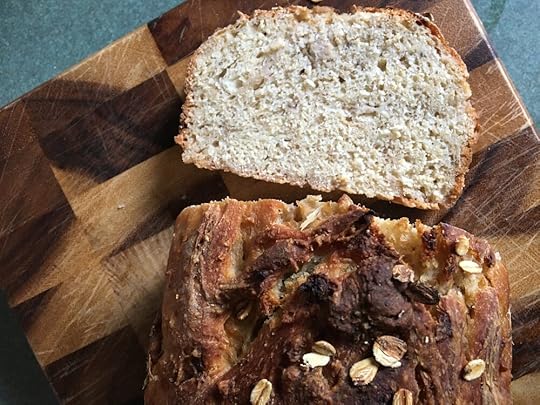
I found myself with half a saucepan of porridge leftover from our breakfast last week, when things were still relatively normal. If it were just a spoonful or two, I’d just put it in our compost but it looked like enough for another serve, at least. I abhor waste but cold porridge was not appealing. I seemed to remember reading a recipe for bread you could make with leftover porridge, so I googled it and there it was! The brainchild of Claire Thomson, this bread is absolutely magnificent. Tom and I devoured it. Perfectly with butter and jam, or just plain. It’s even nicer if your porridge was made with a hint of cinnamon in it, as ours was!
2) Seedy soda bread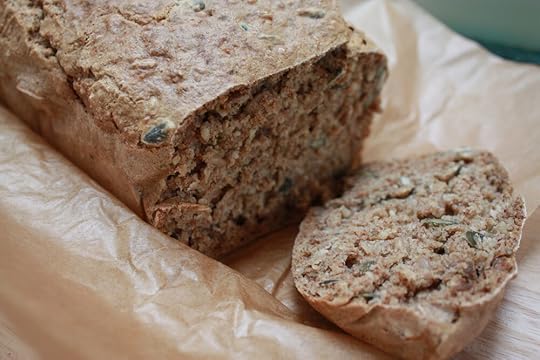
I have been making this bread for years. It’s one of the easiest things in the world to make - I’ve even made it when recovering from the flu. No yeast, the lovely tang of bicarb soda and the goodness of seeds. You can add raisins or sultanas too if you like, but as my husband is averse to dried fruit, I go for all seeds. It’s amazing with ricotta and jam, or just plain.
3) Dutch oven bread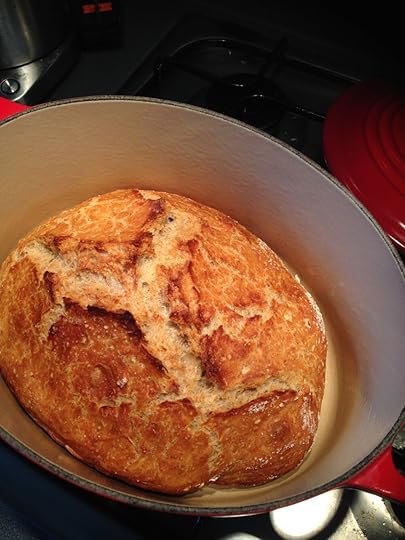
Everyone’s heard of this one, surely? There are many recipes from it, including one from the New York Times, but the one I’ve linked to is the one I’ve used the most. Lots of useful tips if you’re a first-timer. This is a bread I make all the time. Again, no kneading involved but just a longer prove so you’ll have to be a bit organised with this one and start it the night before. You can also add some sourdough starter to it if you have some. It tastes like you’ve put way more effort into it than you actually have!
4) Easy gluten-free bread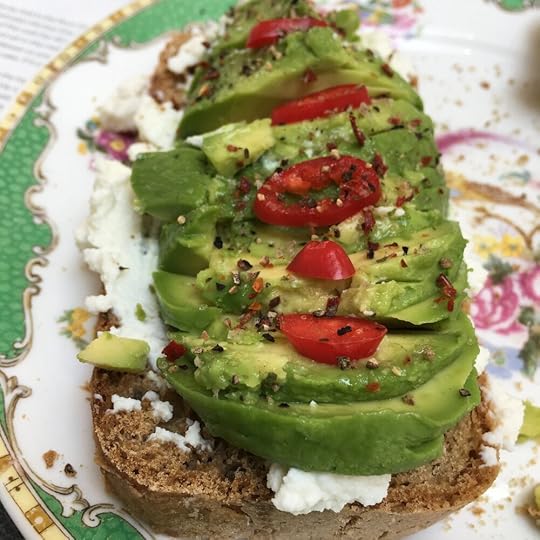
I don’t make this as often as I used to, as I find gluten-free flour more expensive here in Australia than it was in the UK (or maybe it’s because I still see the £ sign instead of $?) but it’s still a lovely easy loaf to make when you want a GF option. It’s more like making a cake than a loaf of bread, really. And if you have a breadmaker, like I do, there’s practically no labour involved at all!
I love it a day old, toasted, smothered with avocado and chilli, like the picture!
5) Banana bread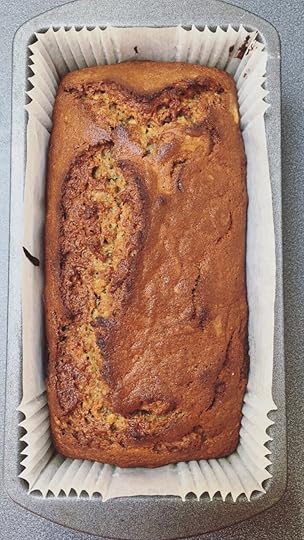
Counts as a bread, surely? If you’ve got lots of bananas to use up at home, look no further. Super easy and absolutely delicious. We all need a sweet treat right now, I think.
I hope you enjoy these and please let me know if you try any of them!
Stay well and hopeful my friends xx
March 14, 2020
interview with balance the grind

Image by Jeanine Stewart
Thank you to Balance the Grind for featuring me in their Conversations about Work, Life and Balance series.
It was great talking to them about my (not quite) typical working days, long and winding career paths, juggling freelance life with PhD life, writing, courage, self-compassion and changing your narrative.
It has taken a while to untangle my sense of self-worth from my productivity and achievements but ultimately it has resulted in getting what I always wanted – being able to do work I love, having more control over my time and the freedom to follow the deepest, truest yearnings of my creative soul. That is the engine that drives me now.
You can read the interview here.
January 8, 2020
my favourite reads of 2019
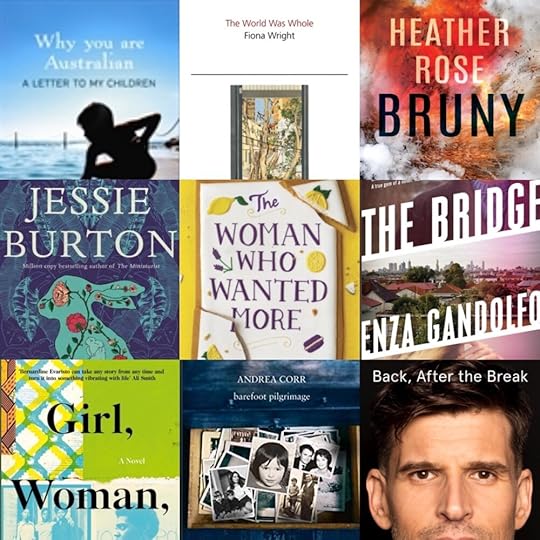
Another year over, and another favourite reads of the year post to write! But at least I’m not writing this in February or, as I did one year, August.
2019 was a wonderful reading year for me where I made up for being away from Australia for nearly 12 years and gulped down literature I had heard about but not managed to get my hands on - and I have only just scratched the surface! I feasted heartily on fiction and non-fiction alike. According to Goodreads, I read 108 books in 2019 - I’m sure I missed logging a couple (and I haven’t logged any I’ve read for my studies) - and of those 108:
2 were re-reads
57 were non-fiction
4 were poetry collections or plays (I thought I’d read more - clearly not!)
47 were fiction
10 were by men
98 were by women
5 were by women of colour.
I won’t lie, I’m surprised and really disappointed in myself for the last one, especially with the countless amazing indigenous writers in this country. I honestly thought it was more than that, as the five I read had a huge effect on me and I thought about them a lot - but that is hugely disproportionate. I clearly need to up my game in this regard to read more widely and beyond my own world view. It is something I will be more conscious of this year.
It was, as always, hard to choose my favourites of the year but I narrowed it down to these 11.
Conversations with Friends by Sally RooneyMy aunt gave me this book and also Normal People for my birthday. This was my pick of the two! It’s so compelling, thought-provoking and different. I was not the kind of 21-year-old that Conversations’ main characters are, but I was equally naive and self-righteous and this story about Frances, Bobbi and their “friends” brought it all back! All in all, it’s a very well-executed coming of age story and an interesting exploration of female friendships too. Rooney writes with the kind of restraint I can only dream of. Very worthy of the hype.
Girl, Woman, Other by Bernadine EvaristoA worthy winner of this year’s Booker Prize - this is a magnificent book that deserves to win every prize it’s eligible for! Girl, Woman, Other shines a light on contemporary Britain in a way I’ve rarely seen in other books - other reviews have described it like a choir of different women’s voices, and I think that’s very accurate! It reads like a beautiful prose poem, with a cast of fascinating characters, all of whom have a story of either racism, prejudice, abuse, misogyny or poverty (often all of them) which they fight to overcome. The writing is so visceral and poetic - you are in these characters’ shoes, hearts, heads and beds. And you won’t forget them in a hurry.
I learned a lot reading this book, not just about issues I have been privileged not to experience firsthand but about humanity. This book is a perfect example of how fiction is often the perfect vehicle for the greatest concerns of our time.
A beautifully written memoir that you can see is actually trying to capture the feeling of memory, of remembering. The narrative is subtle in parts, but surprisingly revealing too. Andrea is a woman who owns her success but also her vulnerabilities. The story she shares in this book is mostly about what it’s like to not have your parents alive anymore, about the preciousness of life, and the desire to capture what you remember before you too are no longer here. If you’re a Corrs fan, you’ll adore it. But you’ll also enjoy it and be moved if you like to read memoirs that are a bit different and poetic. The Corrs’ last album Jupiter Calling has the same mood - trying to capture the beauty and pain of life in one container. Beautiful, and highly recommended.
Why You Are Australian: A Letter to My Children by Nikki GemmellThis book was a much-needed companion in January 2019. Tom and I had been back in Australia for only a few weeks and I felt dazed and disoriented, like a time traveller. Not that we doubted the decision to move back here, not for a second, but the move brought up a lot of discomfort and a lot of things I hadn’t realised I still needed to face. Gemmell quotes Les Murray (being interviewed by Ramona Koval) quite early in the book - “I came back to go mad. That’s what you do if you’ve got old, unfinished business back in a place and you go back there, you’ll tend to deal with it. “ Oh how those words rang true.
In this book, Nikki Gemmell and her husband - Australians who had lived in the UK for over 10 years and now raising a young family - decide, after a series of life-altering events, that perhaps moving home is the answer. Nikki articulates so beautifully (better than I ever could) the ache for home, for the familiar, for space, for warmth, for family; and also the resistance and sadness when you start dismantling the home and life you chose and created for yourself, even though it doesn’t feel like home anymore. Nikki wants to give her children the carefree, idyllic childhood she had. And so they begin the process to return and decide to do a trial run, spending a few months in Australia with the children, enrolling them in schools, etc. Australia is still a wonderful place, and the children love it. But Nikki does find herself wrestling with what lies underneath Australia’s sun-drenched “she’ll be right mate” reputation - the ugliness of racism and overt nationalism, tall poppy syndrome, natural disasters - and has to consider whether the Australia she grew up in is now a thing of the past.
I felt so seen reading this book - the aspects of life in London that Nikki loved but that also drove her mad were also some of my biggest joys and frustrations; her yearnings for Australia were the same as mine, and the things that she found difficult and alienating when she returned have also been some of my experiences. It’s a nostalgic but honest and (as always) beautifully written book. Highly recommended for any returning expat!
Back, After The Break by Osher GünsbergI was not expecting this to be one of my reads of the year, but on reflection it simply had to be. In 2018 I listened to an interview with Osher where he confessed to working on edits of this book in the cab to the studio! The interview was fascinating so when I saw the book at the library last summer I was curious to give it a read.
I wasn’t prepared for how compelling a book it is - this is honest, frank and brave writing. While some of Osher’s decisions and aspects of his lifestyle are not always easy to empathise with, many of the insights he has on his road to redemption I found very relatable.
I had tears in my eyes when he writes about reclaiming a sense of identity through changing his name. His stability and sense of worth have certainly been hard-won. This excellent, compulsively readable book shines a bright light on mental illness and works hard to dispel the stigma around it. It’s a very important book and one I am still thinking about nearly a year later.
In my attempt to read all the books on the Stella Prize longlist, I picked this one up in March last year - by the end of 2019 it was still one of the best books I’d read all year. This is a stunning collection of essays about life, chronic illness, friendship, love, family, animals, travel and belonging - and particularly the need to feel at home, in many senses of the word. I absolutely loved it and it made me seek out and read all of Fiona Wright’s work, particularly her poetry. She’s a wonderful writer.
The Woman Who Wanted More by Vicky ZimmermanCharming, funny and uplifting, The Woman Who Wanted More is a wonderful read from a talented writer. It is a celebration of food and female friendship, full of insights about life, the choices we make and the effect those we encounter have on us. Heartbreak is always best remedied with food and with good friends, and this book shows why. It's an empowering reminder that life is full of opportunities, once we are open to them. And that admitting you've failed is "not really failure; it's the first step towards the future". Highly recommended!
The Bridge by Enza GandolfoA very relatable story about loss, grief, guilt, redemption, family and community. I could barely put it down - one night I just kept reading until the battery on my Kindle died. The characterisation is superb, I particularly liked Sarah, the court-appointed lawyer. The descriptions of Melbourne are spot on - I spent a lot of time in the parts of the city where the novel takes place and it was a pleasant trip down memory lane, despite the sadness of the story. Compulsive and moving reading, I highly recommend it.
The Priory by Dorothy WhippleI am yet to read a Dorothy Whipple book that I don’t declare magnificent - she is a simply wonderful writer and probably one of the twentieth-century’s most under-appreciated. The main story of The Priory takes place around the crumbling estate of Saunby, which has been in the family for generations but now being run into the ground by Major Marwood whose main priority in life is cricket. He is reluctant to spend money on anything else, including his two grown daughters Christine and Penelope (who still live in the estate’s nursery!) and his spinster sister, Victoria. All of this changes when the Major decides it’s time he remarried. His new wife, Anthea, is determined to get her new home into some sort of order and does away with many relics of the estate’s former life - including the hapless cook Mrs Nall and the Major’s beloved cricket - and, finding herself pregnant with twins (to the Major’s great horror), decides Christine and Penelope must leave the nursery and engages a no-nonsense nanny Nurse Pye (reminiscent of Sister Evangelina in Call the Midwife!) to come and live with the family and help her with the new babies. Christine and Penelope are aghast and actively look for ways they might be able to escape. Unfortunately, as they didn’t have much of an education and therefore have little chance of getting decent jobs to support themselves, their only option is to get married themselves.
Behind the scenes - or below-stairs - are the lives of the servants at Saunby, equally interesting and full of drama. There’s a love triangle between the Major’s right-hand man Thompson, a former professional cricketer, and the two maids, sweet and sunny Bessy and the manipulative Bertha, which plays out very dramatically!
It’s a fascinating novel and entirely absorbing. I love Whipple’s stories for their remarkable insights into human nature and observations about the changing nature of life, and The Priory is no exception. It’s a treat to see the characters grow and change too as they adapt to their altered circumstances - some characters start off as admirable, earnest and well-meaning but turn out to be very selfish, and vice versa. This novel also explores the lack of options available for women at the time - if a marriage did not eventuate or, even worse, failed, things really could get very desperate (and indeed they do for some women in this book). I loved the ending, as it was so hopeful, though it was also tinged with sadness, knowing that the Second World War was just around the corner.
The Confession by Jessie BurtonOf her three novels, I think this is Jessie Burton's finest and the one I have most enjoyed so far. It's an intimate, intelligent and compelling novel that explores the lives of several different women. It takes place across two timelines - the early 1980s in London, LA and New York, and 2017-18 in London. The characters are well-drawn, believable and tender - Connie, in particular, is brought to life very well, I had visions of Eileen Atkins playing her in a TV adaptation if it goes that way! - and though it's an emotional and absorbing tale, there's also a lot of humour. Rose's nice enough but ultimately ineffectual boyfriend Joe with his burrito business Joerritos, for example, and the emotional strain of spending Christmas in the middle of nowhere with your strange in-laws!
While ultimately there is one big confession which the story builds towards, The Confession actually contains many of them. So many of the characters aren't telling the truth, to others or to themselves. But it is possible, they discover, to free yourself from the ghosts of the past. New beginnings are always possible - but you have to choose them. I actually found more sage life advice in the pages of this novel than I did in some motivational books I read last year. This is a novel I can see myself rereading, and I don't say that often.
Another magnificent novel from Heather Rose - she never disappoints. I highly recommend reading the the prologue of this book with Ludovico Einaudi’s “Uno” on the stereo - it wasn’t a deliberate pairing on my part, but an accidental one, and it only heightened the tension evident in the first few pages! Bruny is quite a departure for Heather Rose in terms of subject matter - this is a political thriller about the smoke and mirrors world of modern governments and overdevelopment - but it also delivers what she’s always done best. And as a recently returned Tasmanian, I had a good laugh at the digs she makes at this state and its inhabitants (they are so true)! Bruny is a dystopian family drama that will make you think and probably weep. The world in it is all too recognisable. Most of all, it is a plea to us all to fight to protect the places we love.
***
So, reading goals for 2020 - try to do some non PhD reading (hard but essential for the maintenance of sanity) and read more widely. More diverse writers, more indigenous Australian writing. More poetry. I want to be challenged. If you have any recommendations, please let me know in the comments.
As always, I’d love to hear your favourite reads of the last year too!
PS: As I mention every year, any links to Amazon are affiliate links. This means if you click on the link and end up making a purchase, I get a small commission. Many thanks for your support xx
November 14, 2019
blueberry pancakes for one
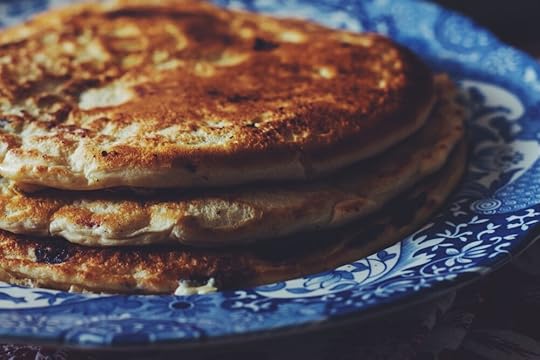
For those mornings where it’s just you (or you’re the only one who feels like pancakes), this is the pancake recipe you need! It makes the perfect amount for one - three large pancakes, or five to six smaller ones if you feel like sharing.
You can use any berries you like, or other fruit (slices of banana are nice) or chocolate chips. I put a few halved pecans in with the blueberries on my last pancake when I made a batch, and that was rather tasty. You could even (gasp) leave them plain!
Blueberry pancakes for one1 large egg
1 cup (250 g) self-raising flour
1 cup (250 ml) milk of your choice (I used almond)
A pinch of sea salt
A pinch of cinnamon or mixed spice (optional)
A few handfuls of fresh or frozen blueberries
Greek yoghurt and honey, to serve
I make the mixture in a large jug, which makes making the pancakes incredibly easy and less messy. As you’re only making enough pancakes for one, there will be plenty of room to whisk everything up. So grab yourself a large jug.
Crack in the egg and whisk briefly to combine the yolk and white. Add the flour, milk, salt and cinnamon (if using) and whisk everything together (I use a small sauce whisk but a fork should work just as well) until combined and smooth.
Get a small non-stick frying pan (I use a 24cm one from Kmart) and spray with cooking spray - you can, of course, put some flavourless oil or butter in, but I find spray works best for pancakes. Place the pan over medium-high heat to get the pan nice and hot. Test if it’s ready by running your fingers briefly under the tap and flicking it at the pan. If it sizzles, you’re ready to make pancakes.
Pour a third of the pancake mixture into the pan and distribute around slightly to get the size/thickness you want. Turn the heat down slightly, not super low but low-ish. Grab a handful of blueberries and scatter over the surface of the uncooked side of the pancake. Leave to cook for a few minutes, until you can see bubbles on the surface of the uncooked side. Sometimes it’s worth having a peek underneath to make sure the other side isn’t getting too brown. I find the trick of having a hot pan to start with but then reducing the heat once you’ve poured the mixture in is very helpful. Flip the pancake over and cook the other side. Press gently on the top to see if it’s cooked - if no raw mixture peeks through, you’re good!
I then place the cooked pancake on the plate I’m going to eat them on and put that in a low oven to keep warm while the rest of them cook.
Cook the remaining mixture as above.
Remove the plate from the oven and serve - I love to eat pancakes with Greek yoghurt and honey, which reminds me of a happy trip to Cyprus Tom and I made some years ago, for our sixth wedding anniversary. Next year is our tenth! Can you believe it?
Enjoy your pancakes, your coffee and your weekend. And if it isn’t the weekend yet, pancakes for breakfast always make you feel like it is.
October 30, 2019
are you going to behave today?

I was in a cafe today, with a new friend. We ordered our drinks - a chai for me, a peppermint tea for her. The server asked us breezily, “any of the sweets? Or are you going to behave today?”
Those words rang in my ears all day.
Not because I was angry. Or confused. Or sad. Maybe I was all those things. But I think I was more curious than anything. Why is that an acceptable thing to say? My friend didn’t even seem to notice the question. We just said no and continued our conversation. But if I had ordered a cake, would that have meant I was MIS-behaving?
It got me thinking about the belief system - that is so ingrained in our (white Western privileged) culture - that assigns moral value to food and food behaviour. Where some foods are “good” and others are “bad”. Where if you make a healthy choice you’re “being good”. Where if you’re slim it is assumed you have self control and if you’re overweight, you do not.
I have spent the past decade actively trying to free myself from that system.
And in the process, I have realised how much our (white Western privileged) society rewards people for conforming to the idea that you have to be slim to be successful and happy (I was one of them!) and shames and punishes those who don’t.
I have done a lot of untangling of the diet culture these past few years, and pondered my own role in it. While I know that I never actually said the words “losing weight is the answer to all your problems”, I can see why people thought I was because I didn’t have to. For a time, my very existence was a walking advertisement for the lie we are sold. Lose weight and hey presto, you’ll get to live the life you’ve always wanted! You’ll be popular, people will like you! Everything will be great!
And yes, that was my life, for a while. But like everything, it only appeared perfect on the surface, and it came with a price.
I know this all must sound strange coming from someone who started a weight loss blog 15 years ago and who revelled in the loose jeans, in getting to goal, in being admitted to that secret world where nothing tasted as good as being slim felt (which is bullshit - a fuck load of things taste that good!). It was only once I achieved it that I realised how dangerous it was.
Staying in that world depending on me following those rules. The confidence that came with the achievement was so incredibly flimsy, still so heavily reliant on external validation. All it would take was one card to be pulled out for the whole house to come falling down, which is exactly what happened.
But I’m now living beyond the after photo. The after photo was a golden time, and in many ways I’d have been happy if life could have carried on like that forever, because the highs were so high, so unforgettably wonderful. But the lows….well, if you’ve read The Latte Years, you’ll know all about those.
Nothing lasts. Change is the only constant in this crazy life. You cannot freeze time. I’d much rather be here, now, where I feel less concerned about what I look like and more about what kind of good I’m doing in the world and what sort of legacy I will leave behind.
A life where I know that eating a piece of cake is, in every sense of the word, good.
October 22, 2019
vegan chilli with chocolate and chia seeds
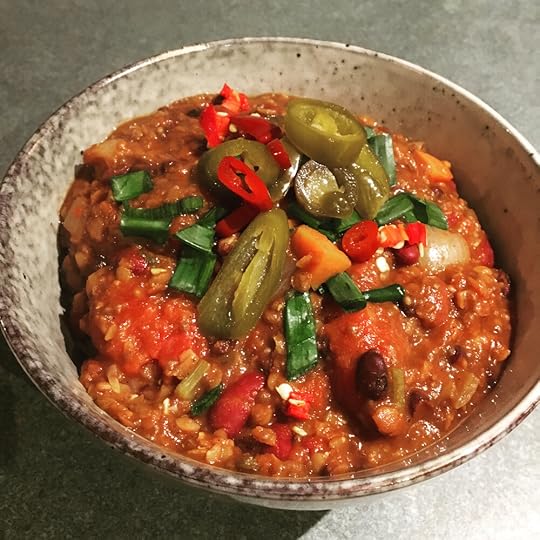
Chocolate and chia seeds? Do those things really belong in a savoury dish?
I am here to tell you they most certainly do!
As we’ve - still - been experiencing bone-chillingly cold nights here in Tassie, comforting and warming meals like chilli are still de rigeur in my household. To this one, I added a couple of squares of 90% dark chocolate (which adds an amazing depth of flavour) and, because there was too much liquid at the end of cooking for my liking, chia seeds. They soak up liquid like magic!! As a result this was probably the healthiest (and most delicious) bowl of chilli I’ve ever eaten.
And though the weather seems to be finally warming up, I won’t be disappointed if I have to make this again any time soon!
What follows is the combination of beans and lentils I used, but you can naturally use any you have to hand.
Vegan chilli with chocolate and chia seeds1 large onion, finely chopped
2 garlic cloves, finely chopped
1 red chilli, finely chopped
2 large carrots, finely chopped
1 bunch parsley stalks (or a few sticks of celery), finely chopped
1 x 400 g tin black beans, drained and rinsed
1 x 400 g tin kidney beans, drained and rinsed
2 teaspoons Pasillo chilli powder (or any other chilli powder you like - I also like Ancho chilli flakes)
3 teaspoons dried cumin
1 bay leaf
200 g red lentils
1 x 800 g tin whole plum tomatoes
2-3 tablespoons chipotle sauce
2-3 tablespoons tomato paste
2-3 teaspoons vegan “beef-style” stock powder made up with enough boiling water to cover
2-3 squares vegan dark chocolate (I use Lindt 90%)
4-5 tablespoons chia seeds, depending on thickness desired
Salt and pepper to taste
To serve: cooked brown basmati rice, finely sliced spring onions, pickled jalapenos, sharp grated cheddar, greek yoghurt (obviously adding the last two will make it vegetarian rather than vegan)
Heat a splash of olive oil in a large, flameproof casserole dish (I use my Le Creuset) over a medium to high heat and add the onion, garlic and chilli. Saute for a minute or two until soft and fragrant, then add the diced carrots and chopped parsley stalks (I used these because I had them on hand, and they taste remarkably like celery! But use whatever vegetables you have).
Add the drained beans, then the chilli powder, cumin and bay leaf. Toss everything around to get coated in the spices, adding a splash of water if things start sticking. Saute for a few minutes until slightly softened.
Add the lentils, tomatoes, chipotle sauce and tomato paste, stirring to combine everything well. Then add enough “beef” stock to cover the mixture. As lentils absorb so much liquid, I err on the side of caution and sometimes add a bit more liquid than I need. I would rather add chia seeds to soak up the liquid at the end of cooking - adding insufficient liquid in the first place can lead to a rather desperate rescue operation!
Stir well, ensuring nothing is stuck to the bottom of the dish. Allow the mixture to come to the boil and then reduce the heat to low, cover with a lid and cook for 20-25 minutes, until the lentils are soft.
Add the dark chocolate, stirring well to ensure it melts and the flavour is evenly distributed. Add chia seeds at this stage too. You may not need very many, only a tablespoon or so, depending on how much liquid is left. If there is quite a bit, you’ll need to add a few more tablespoons. It’s great fun to watch, these tiny seeds soaking up the stock like magic! You still want some liquid though, so take your time and add judiciously, stirring constantly.
Once the chilli is thickened to your liking, taste and add salt and pepper if you need. Turn off the heat and allow to sit while you assemble all your fixings.
Serve in bowls with rice and topped with whatever you fancy - I love the pickled chillies and jalapenos you can get in jars at the supermarket. This way, I can make the chilli mild enough for heat-averse family members but my portion can be as hot as I like it.
Any leftovers can be frozen or stored in the fridge to reheat the next day, by which time the subtle fruity notes of the dark chocolate will be even more apparent!
Philippa Moore's Blog
- Philippa Moore's profile
- 7 followers



